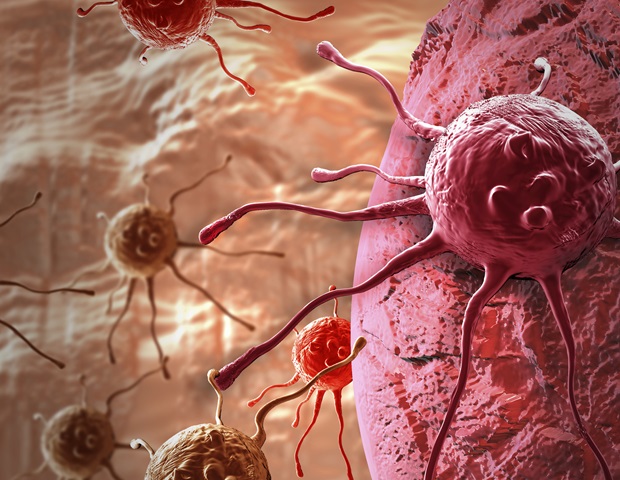Imagine a world where your own immune cells are transformed into cancer-fighting superheroes. This is the promise of CAR-T cell therapy, a groundbreaking treatment that’s already saving lives.
In this therapy, patients’ own immune cells are collected, genetically engineered so that they specifically target cancer cells, then returned to the body. The result is a potent new option for battling blood cancers. However, as with any superhero journey, the process of harnessing this incredible power comes with its own set of challenges.
One such hurdle: Current methods for activating T cells don’t resemble closely enough the natural environment in which they interact with another key population of immune cells -; a connection crucial for activating T cells and ramping up their ability to fight cancer.
In a recent Nature Nanotechnology study, a UCLA team has unveiled a powerful tool to overcome this limitation. Their new platform combines a flexible material called graphene oxide with antibodies to closely mimic the natural interactions between immune cells. The investigators found that this mimicry shows a high capacity for stimulating T cells to reproduce, while preserving their versatility and potency.
The advance could make CAR-T cell therapy more effective and accessible, while also driving progress for other emerging treatments.
Our interface bridges the gap between the laboratory and actual conditions inside the body, allowing us to gain insights much more relevant to real-world biological processes. Beyond T cell therapies, we can apply this technology to a variety of fields including tissue engineering and regenerative medicine.”
Yu Huang, the Traugott and Dorothea Frederking Professor of Engineering at the UCLA Samueli School of Engineering and member of the California NanoSystems Institute at UCLA (CNSI), co-corresponding author
The researchers anchored two specific antibodies onto graphene oxide. Over 12 days, their platform facilitated a 100-fold-plus increase in T cell expansion in a culture of blood cells. The technology also enhanced the efficiency of engineering immune cells, leading to a five-fold increase in CAR-T cell production compared to the standard process. The team also identified several biochemical pathways crucial for T cell signaling and function that were activated by their technology, enabling the increase in growth and efficiency.
Schematics and electron microscopy images show how UCLA technology closely mimics important natural interactions between the T cell and another key type of immune cell, action that may enhance a breakthrough treatment for blood cancers.
“We’ve developed an exciting new approach to boosting the effectiveness of T cell therapies,” said co-corresponding author Lili Yang, a professor of microbiology, immunology and molecular genetics at the UCLA College, as well as a member of the Eli and Edythe Broad Center of Regenerative Medicine and Stem Cell Research at UCLA (BSCRC) and of the UCLA Health Jonsson Comprehensive Cancer Center. “Our method enhanced the potency and efficiency of these cells in ways that weren’t possible with traditional methods. This is particularly important for CAR-T cell therapy, where the strength and proliferation of T cells makes a significant difference in patient outcomes.”
Today, the lab-based portion of generating CAR T cells requires the addition of a specific immune factor called autocrine interleukin-2, or IL-2. The researchers found that their platform stimulated production of IL-2, which may make that addition unnecessary.
“We got very excited when we discovered that our method can overcome the dependence on external IL-2 supplementation,” said UCLA postdoctoral fellow Enbo Zhu, co-first author of the study. “We confirmed that our rational design for mimicking an important immunological interaction is on the right track. It encourages us to dive deeper into developing its applications in CAR-T cell therapy.”
Co-first author Jiaji (Victor) Yu, who earned a doctorate from UCLA in 2021, added: “This work depended on cross-disciplinary collaboration, merging the fields of immunology, materials science and engineering, nanotechnology and bioengineering. With teamwork like this, as well as innovation, perseverance, and a deep commitment to finding better ways to fight cancer, we’re building a future where genetically engineered superpowers aren’t just in comic books -; they’re in our hospitals, saving lives.”
The study’s other co-authors are Yan-Ruide Li, Feiyang Ma, Yu-Chen Wang, Yang Liu, Miao Li, Yu Jeong Kim, Yichen Zhu, Zoe Hahn, Yang Zhou, James Brown, Yuchong Zhang, Matteo Pelegrini, and Tzung Hsiai, all of UCLA.
The seed funding for this research was provided by a Eli and Edythe Broad Center of Regenerative Medicine and Stem Cell Research at UCLA and California NanoSystems Institute at UCLA Planning Award.
Source:
Journal reference:
Zhu, E., et al. (2024). Biomimetic cell stimulation with a graphene oxide antigen-presenting platform for developing T cell-based therapies. Nature Nanotechnology. doi.org/10.1038/s41565-024-01781-4.


